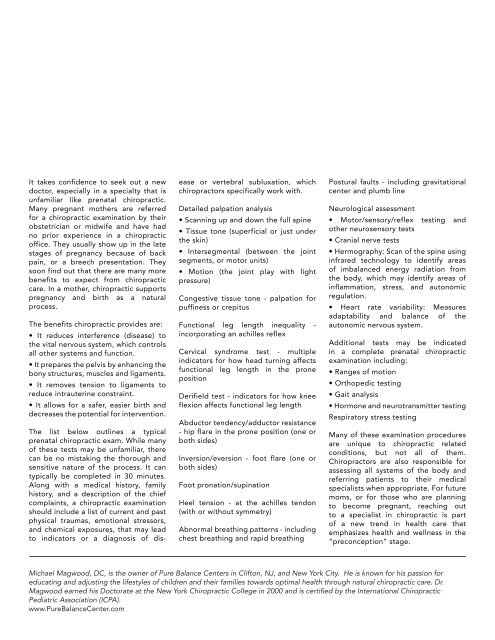24 Seven July 2018
Change Your Attitude… Change Your Life: 24/seven is a monthly, free magazine for personal growth, professional development, and self-empowerment. The approach is holistic, incorporating mind, body, soul, and spirit. As philosopher Francis Bacon said, “Knowledge is power.” Use this information to live your best life now.
Change Your Attitude… Change Your Life: 24/seven is a monthly, free magazine for personal growth, professional development, and self-empowerment. The approach is holistic, incorporating mind, body, soul, and spirit. As philosopher Francis Bacon said, “Knowledge is power.” Use this information to live your best life now.
Create successful ePaper yourself
Turn your PDF publications into a flip-book with our unique Google optimized e-Paper software.
It takes confidence to seek out a new<br />
doctor, especially in a specialty that is<br />
unfamiliar like prenatal chiropractic.<br />
Many pregnant mothers are referred<br />
for a chiropractic examination by their<br />
obstetrician or midwife and have had<br />
no prior experience in a chiropractic<br />
office. They usually show up in the late<br />
stages of pregnancy because of back<br />
pain, or a breech presentation. They<br />
soon find out that there are many more<br />
benefits to expect from chiropractic<br />
care. In a mother, chiropractic supports<br />
pregnancy and birth as a natural<br />
process.<br />
The benefits chiropractic provides are:<br />
• It reduces interference (disease) to<br />
the vital nervous system, which controls<br />
all other systems and function.<br />
• It prepares the pelvis by enhancing the<br />
bony structures, muscles and ligaments.<br />
• It removes tension to ligaments to<br />
reduce intrauterine constraint.<br />
• It allows for a safer, easier birth and<br />
decreases the potential for intervention.<br />
The list below outlines a typical<br />
prenatal chiropractic exam. While many<br />
of these tests may be unfamiliar, there<br />
can be no mistaking the thorough and<br />
sensitive nature of the process. It can<br />
typically be completed in 30 minutes.<br />
Along with a medical history, family<br />
history, and a description of the chief<br />
complaints, a chiropractic examination<br />
should include a list of current and past<br />
physical traumas, emotional stressors,<br />
and chemical exposures, that may lead<br />
to indicators or a diagnosis of disease<br />
or vertebral subluxation, which<br />
chiropractors specifically work with.<br />
Detailed palpation analysis<br />
• Scanning up and down the full spine<br />
• Tissue tone (superficial or just under<br />
the skin)<br />
• Intersegmental (between the joint<br />
segments, or motor units)<br />
• Motion (the joint play with light<br />
pressure)<br />
Congestive tissue tone - palpation for<br />
puffiness or crepitus<br />
Functional leg length inequality -<br />
incorporating an achilles reflex<br />
Cervical syndrome test - multiple<br />
indicators for how head turning affects<br />
functional leg length in the prone<br />
position<br />
Derifield test - indicators for how knee<br />
flexion affects functional leg length<br />
Abductor tendency/adductor resistance<br />
- hip flare in the prone position (one or<br />
both sides)<br />
Inversion/eversion - foot flare (one or<br />
both sides)<br />
Foot pronation/supination<br />
Heel tension - at the achilles tendon<br />
(with or without symmetry)<br />
Abnormal breathing patterns - including<br />
chest breathing and rapid breathing<br />
Postural faults - including gravitational<br />
center and plumb line<br />
Neurological assessment<br />
• Motor/sensory/reflex testing and<br />
other neurosensory tests<br />
• Cranial nerve tests<br />
• Hermography: Scan of the spine using<br />
infrared technology to identify areas<br />
of imbalanced energy radiation from<br />
the body, which may identify areas of<br />
inflammation, stress, and autonomic<br />
regulation.<br />
• Heart rate variability: Measures<br />
adaptability and balance of the<br />
autonomic nervous system.<br />
Additional tests may be indicated<br />
in a complete prenatal chiropractic<br />
examination including:<br />
• Ranges of motion<br />
• Orthopedic testing<br />
• Gait analysis<br />
• Hormone and neurotransmitter testing<br />
Respiratory stress testing<br />
Many of these examination procedures<br />
are unique to chiropractic related<br />
conditions, but not all of them.<br />
Chiropractors are also responsible for<br />
assessing all systems of the body and<br />
referring patients to their medical<br />
specialists when appropriate. For future<br />
moms, or for those who are planning<br />
to become pregnant, reaching out<br />
to a specialist in chiropractic is part<br />
of a new trend in health care that<br />
emphasizes health and wellness in the<br />
“preconception” stage.<br />
Michael Magwood, DC, is the owner of Pure Balance Centers in Clifton, NJ, and New York City. He is known for his passion for<br />
educating and adjusting the lifestyles of children and their families towards optimal health through natural chiropractic care. Dr.<br />
Magwood earned his Doctorate at the New York Chiropractic College in 2000 and is certified by the International Chiropractic<br />
Pediatric Association (ICPA).<br />
www.PureBalanceCenter.com


















